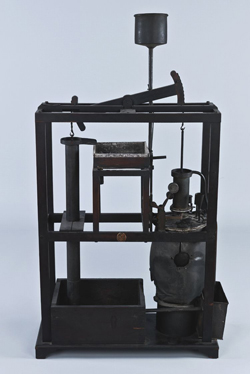Model Newcomen Steam Engine
British, mid-18th century
Probably manufactured by Jeremiah Sisson, London
Metal, wood
Repairing this model steam engine for the University of Glasgow in the early 1760s led the young James Watt to consider improvements to steam engine technology, and ultimately the creation of the separate condenser, a crucial development in the Industrial Revolution.
GLAHM C.29
On display in the Hunterian Museum (Science Balcony)
In the early 1710s Thomas Newcomen (1664-1729) invented an atmospheric steam engine, principally for pumping water out of mines. A boiler produced steam, which entered a open-topped cylinder. Within the cylinder was a movable piston, attached by a chain and a pivoting beam to pump rods which descended into the mine. When a spray of cold water was injected inside the cylinder, the steam condensed, which formed a partial vacuum. The greater atmospheric pressure outside the cylinder pushed down the piston, which in turn raised the pump rods. Numerous full-size Newcomen engines were built across the United Kingdom in the middle of the 18th century, enabling deeper and more extensive extraction of resources such as coal and metals.
In the 1750s this model Newcomen engine resided in the University of Glasgow's premises on the High Street. It was presumably used for teaching, demonstrating and experimenting. In 1756 the 20-year-old Scottish instrument maker, James Watt (1736-1819) was employed by Professor of Natural Philosophy Robert Dick (1722-1757), to repair some astronomical instruments. This resulted in Watt establishing a workshop within the University and styling himself 'Mathematical Instrument Maker to the University'. In this role Watt was exposed to the vibrant community of experimenters and theorists in Enlightenment Glasgow, such as Dick's successor, John Anderson (1726-1796), chemist Joseph Black (1728-1799), who was developing a theory of latent heat, and many others.
Watt was asked by Anderson to repair the University's model Newcomen engine in the winter of 1763-4, which led him to consider experiments to improve it. Watt's realisation in 1765 was that a great deal of heat was wasted in the condensation process, as the cylinder was repeatedly cooled and heated. His key innovation to steam engine technology was the invention of the separate condenser, which condensed the steam in a separate vessel, reducing the heat wastage and greatly improving the engine's efficiency. In collaboration with his later business partner Matthew Boulton (1728-1809), Watt's improved steam engines were significantly more efficient than Newcomen's, a business success, and a milestone in the Industrial Revolution. Although there is no evidence that Watt ever attached a separate condenser to this specific model engine, it remains a highly important object in the world history of engineering and industry.

